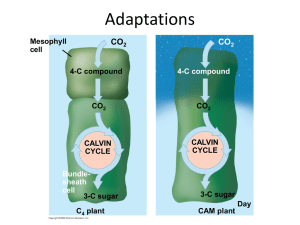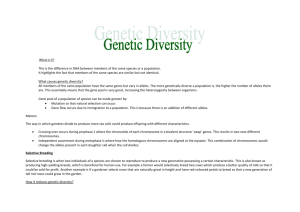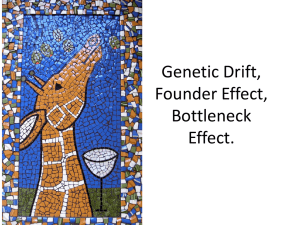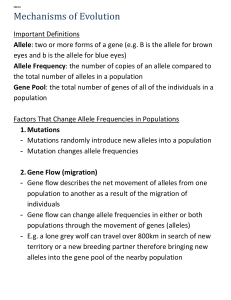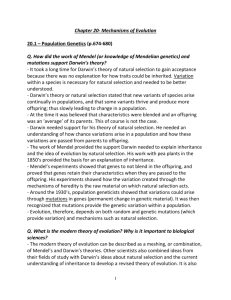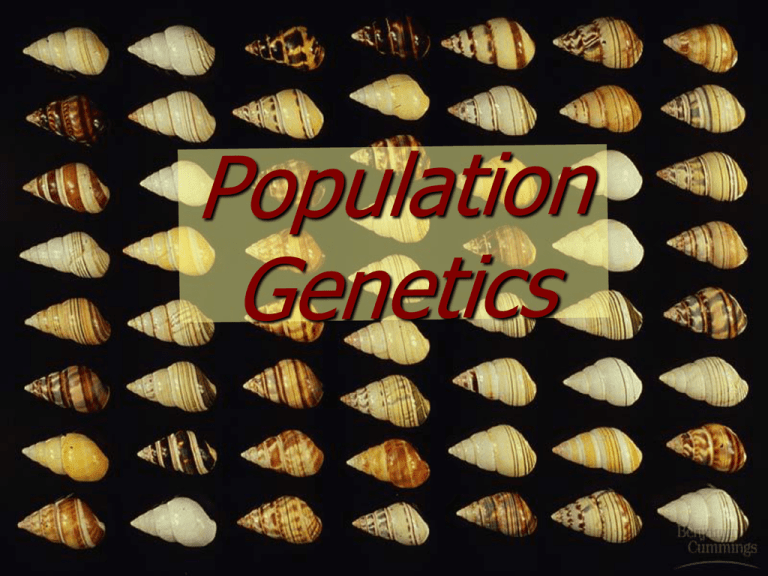
Gene Pool
-
all alleles of all
individuals in a
population
species:
interbreed
& produce
fertile offspring
a shared gene pool
Different
The Gene Pool
species
do NOT exchange
genes by
interbreeding
Different species
that interbreed
often produce
sterile or less viable
offspring e.g. Mule
-
Populations
A group of the
same species living in
an area
No two individuals
are exactly alike
(variations)
More Fit individuals
survive & pass on
their traits
Adaptation
Process when a population becomes
better suited to its environment
finches had to evolve in order to FIT into
environment
Populations living in different places
become increasingly different as each
becomes adapted to its own environment
Process
Speciation
of species
formation
One species may
split into 2 or more
species
A species may
evolve into a new
species
Requires very long
periods of time
At Shambala Preserve, not far from Hollywood, Patrick the liger looks ready for his close-up. The
preserve, run by The Birds star Tippi Hedren, bills itself as "a haven for endangered exotic big
cats."Though few ligers exist, they may not exactly be endangered, since they are not thought to exist in the wild.
It's a matter of geography and genetics: Lions generally live in Africa, tigers in Asia. Plus, interspecies breeding
tends to result in "diminished fitness of the offspring," according to Ronald Tilson, director of conservation at the
Minnesota Zoo in Apple Valley.
• Read "Ligers Make Dynamite Leap Into Limelight"
•—Photograph © by Bill Dow/Shambala Preserve
Divergent evolution
- Related populations become less similar
as they respond to different environments
Accumulate differences
Coevolution – process when 2+ species
change in response to each other
E.g. plants & birds
Homologous structures – feature that
share a common ancestor
different function, similar structure
E.g. whale flipper & human arm
Analogous structure – feature that has
same function with similar structure
But very different internal anatomy &
embryological development
E.g. bird wing and moth wing
Vestigial structures – structure that no
longer serves an important function
E.g. tail bone, wisdom teeth, appendix
Convergent evolution
occurs when the environment selects
similar phenotypes but ancestral type is
very different
E.g. sharks & porpoises (fish & mammal)
Causes of variation
Influenced by environment & heredity
Variations in genotype by:
Mutation
Recombination of genes during meiosis
Random fusion of gametes
Changes in equilibrium due to…
Immigration – movement INTO a population
Emigration – movement OUT of a population
Genetic drift
change in gene pool of small population
due to lack of contributing organism
e.g. Failure to produce offspring or too many
offspring
significant effect of random events or
chance
4 types of natural selection
Stabilizing selection – individuals with
average traits – fittest
Directional selection – environment ‘directs’
individuals with extreme trait to be fittest
E.g. anteater tongue
Disruptive selection – individuals with either
extreme are fittest – it ‘disrupts’ the norm
E.g. lizard size
E.g. limpet shell color
Sexual selection – female attraction to male
E.g. peacock
Isolating mechanisms
Geographic isolation – physical separation
of members of population
MOST COMMON way for new species to form
E.g. canyon, climate
Reproductive isolation – barriers to
successful breeding between groups in
population
E.g. sterile offspring, death before birth, mating
times
Rate of speciation
Gradual formation? gradualism
punctuated equilibrium – sudden shift
in form
Takes a few thousand years instead of a few
million
Modern Synthesis Theory
Combines Darwinian
selection and Mendelian
inheritance
Population genetics study of genetic
variation within a
population
Emphasis on
quantitative characters
Modern Evolutionary Thought
Modern Synthesis Theory
(1940s) –
comprehensive theory
of evolution
Fisher & Wright
Previously many did
not accept that
Darwin’s theory of
natural selection could
drive evolution
S. Wright
A. Fisher
Modern Synthesis Theory on evolution
GENES are responsible for the inheritance
of characteristics
POPULATIONS, not individuals, evolve
due to natural selection & genetic drift
SPECIATION due to the gradual
accumulation of small genetic changes
Changes
Microevolution
occur in gene pools due to
mutation, natural selection, genetic
drift, etc.
Gene pool changes cause more
VARIATION in individuals in the
population
E.g.: Bacteria becoming unaffected by
antibiotics (resistant)
Gene Pools
If
all members of a population
are homozygous for a particular
allele, then the allele is fixed in
the gene pool.
The Hardy-Weinberg Theorem
Used to describe a non-evolving
population.
Shuffling of alleles by meiosis and random
fertilization have no effect on the overall
gene pool.
Natural populations are NOT expected to
actually be in Hardy-Weinberg equilibrium.
Assumptions of the H-W Theorem
1. Large population size
- small populations can have chance
fluctuations in allele frequencies (e.g., fire,
storm).
2. No migration
- immigrants can change the frequency of
an allele by bringing in new alleles to a
population.
3. No net mutations
- if alleles change from one to another, this
will change the frequency of those alleles
Assumptions of the H-W Theorem
3. Random mating
- if certain traits are more desirable, then
individuals with those traits will be selected
and this will not allow for random mixing of
alleles.
4. No natural selection
- if some individuals survive and reproduce
at a higher rate than others, then their
offspring will carry those genes and the
frequency will change for the next
generation.
Hardy-Weinberg Equilibrium
The gene pool of a non-evolving population
remains constant over multiple generations;
i.e., the allele frequency does not change over
generations of time.
The Hardy-Weinberg Equation:
1.0 = P2 + 2Pq + q2
where P2 = frequency of PP genotype
2Pq = frequency of Pq plus qP genotype
q2 = frequency of qq genotype
1.0 = P2 + 2Pq + q2
P
q
P
PP
Pq
q
Pq
qq
1 : 2 : 1
Directional selection
29
Diversifying selection favors extreme over intermediate
phenotypes.
- Occurs when environmental change favors an extreme
phenotype.
Stabilizing selection favors intermediate over extreme
phenotypes.
- Reduces variation and maintains the current average.
- Example = human birth weights.
30
31
Natural selection maintains sexual reproduction
-Sex generates genetic variation during meiosis and
fertilization.
-Generation-to-generation variation may be of greatest
importance to the continuation of sexual reproduction.
-Disadvantages to using sexual reproduction: Asexual
reproduction produces many more offspring.
-The variation produced during meiosis greatly outweighs this
disadvantage, so sexual reproduction is here to stay.
32
Sexual selection leads to differences between sexes
a. Sexual dimorphism is the difference in appearance
between males and females of a species.
-Intrasexual selection is the direct competition between
members of the same sex for mates of the opposite sex.
-This gives rise to males most often having secondary sexual
equipment such as antlers that are used in competing for
females.
-In intersexual selection (mate choice), one sex is choosy
when selecting a mate of the opposite sex.
-This gives rise to often amazingly sophisticated secondary
sexual characteristics; e.g., peacock feathers.
33
34
Five Agents of Evolutionary
Change
Mutation
Mutation rates are generally so low they have
little effect on Hardy-Weinberg proportions of
common alleles.
ultimate source of genetic variation
Gene flow
movement of alleles from one population to
another
tend to homogenize allele frequencies
35
Five Agents of Evolutionary
Change
Nonrandom mating
assortative mating - phenotypically similar
individuals mate
Causes frequencies of particular genotypes to
differ from those predicted by Hardy-Weinberg.
36
Five Agents of Evolutionary
Genetic drift – statistical
accidents.
Change
Frequencies of particular alleles may change by
chance alone.
important in small populations
founder effect - few individuals found new population (small
allelic pool)
bottleneck effect - drastic reduction in population, and gene
pool size
37
Forms of Selection
Disruptive selection
Directional selection
Selection eliminates intermediate types.
Selection eliminates one extreme from a
phenotypic array.
Stabilizing selection
Selection acts to eliminate both extremes
from an array of phenotypes.
38
Kinds of Selection
39
Selection on Color in Guppies
Guppies are found in small northeastern
streams in South America and in nearby
mountainous streams in Trinidad.
Due to dispersal barriers, guppies can be
found in pools below waterfalls with high
predation risk, or pools above waterfalls with
low predation risk.
40
Evolution of Coloration in
Guppies
41
Selection on Color in Guppies
High predation environment - Males
exhibit drab coloration and tend to be
relatively small and reproduce at a
younger age.
Low predation environment - Males
display bright coloration, a larger number
of spots, and tend to be more successful
at defending territories.
In the absence of predators, larger, more
42
Why is genetic variation
important?
variation
global
warming
survival
EXTINCTION!!
no variation
43
Forces that affect allele freq.
1.
2.
3.
4.
Mutation
Migration
Selection
Random (genetic) drift
Selection and migration most important
for livestock breeders.
44


